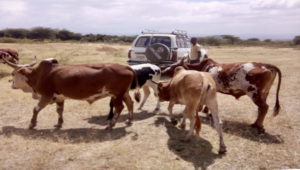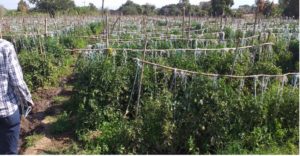Loan Guarantee Fund: A pilot from Ethiopia
The Loan Guarantee Fund provides access to financial services to young entrepreneurs and youth-friendly enterprises in the Oromia and Somali regions of Ethiopia. The fund works by providing youth with access to loans from financial institutions using a guarantee financed by EYW for any collateral required. As a result, 94 youth enterprises have been created (with 68% young women), with 1163 young people benefiting from employment opportunities.
 In Ethiopia, an estimated 11,4% of youth aged between 15-24 were not in employment, education or training in 2018 [1]. This figure tends to be higher for women and youth living in the rural areas. To improve their livelihoods, many young people in rural Ethiopia are motivated to start their own business and diversify their incomes. This is not an easy task, as they have very little business knowledge and are often unable to access loans, training and business development services. Even when there are opportunities from the government or financial institutions, young people face extra obstacles when it comes to taking out a loan to start a business as they often cannot guarantee repayment.
In Ethiopia, an estimated 11,4% of youth aged between 15-24 were not in employment, education or training in 2018 [1]. This figure tends to be higher for women and youth living in the rural areas. To improve their livelihoods, many young people in rural Ethiopia are motivated to start their own business and diversify their incomes. This is not an easy task, as they have very little business knowledge and are often unable to access loans, training and business development services. Even when there are opportunities from the government or financial institutions, young people face extra obstacles when it comes to taking out a loan to start a business as they often cannot guarantee repayment.
What makes this pilot innovative?
The LGF provides youth in the Oromia and Somali regions of Ethiopia with access to financial services for employment and income generation. The fund works by serving as a guarantor for any collateral required for young entrepreneurs or youth-friendly enterprises to take out loans to start up their businesses. The groups are also given business development and financial literacy training.
To access the loans, youth groups of between 5 to 10 members were formed consisting of at least 70% women. Together, each group devised a business plan that they used to apply for a loan. The business topics are selected by youth based on viability in different regions, occasionally with influence from local stakeholders. In Oromia, youth groups were exposed to trainings on entrepreneurship skills, internal group governance and cohesion, profitable business plan development, bookkeeping and financial management. Most groups in both Oromia and Somali regions had a loan repayment period of three years.
Results
-

Employment opportunities were created by the youth enterprises in the LGF scheme for 816 target youth. Additionally, 27 non-target youth benefited from full-time employment opportunities and 320 from part-time work.
- In total, 94 youth enterprise groups were created. 60 enterprise groups having a total of 435 youth (71.3% women) were organized by RCWDO and 60 groups having a total of 353 youth (66% women) were organized by HAVOYOCO. These groups have stayed together for three or more years on average.
- The youth developed good social and group cohesion, teaching the importance and benefits of working in a group over working individually.
- Of the total 816 youth organized into youth enterprise groups, 68.2% were women. These groups demonstrated that women have the ability to work and generate income alongside men and play key roles in group enterprises when they have the opportunity to.

- Youth gained awareness and confidence that they can create their own jobs and improve their livelihoods with the opportunity of having access to financial services.
- As reported by target youth and their parents across the two regions, the organization of youth into groups and providing access to loans has helped the youth become more hopeful, develop aspirations, and sense of responsibility to improve their livelihoods.
Methodology
The project is implemented in partnership with Rift Valley Children’s and Women Development Organization (RCWDO) and Oromia Credit and Saving SC (OCSSCO) in Oromia and the Horn of Africa Voluntary Youth Committee (HAVOYOCO) and Somali Micro Finance Institute (SOMFI) in Somali region. The pilot was set up by creating linkages with financial institutions and establishing the Guarantee Fund, conducting rapid assessments on existing financial products and the potential for designing new ones, followed by testing, promoting and adapting the new financial products and providing training to financial institution and partner staff. Together with Oxfam in Ethiopia, the four implementing partners developed and agreed on the fund’s structure, partner roles and responsibilities, fund management, and risks associated with the fund. This project was also supported by the mobile business development service (BDS) pilot, an EYW pilot that provides business development support, technology and training remotely through an equipped vehicle directly to the youth group enterprises. This enabled the LGF scheme, together with the BDS service that young entrepreneurs need, to have a wider reach.
Lessons learned
- A lack of regular follow-up and monitoring by the MFIs on the performance of youth enterprises led to several challenges, which was in turn caused by little follow-up from the EYW Project Management Unit. Additionally, the MFIs did not perform all of their roles (loan management, risk sharing) as agreed.
- While women made up at least 70% of youth groups, less than half were found to be in leadership positions on average. In Oromia region, there was a reportedly low readiness and willingness of young women in youth groups to come forward and take on leadership positions.10 This illustrates the need for gender-sensitive trainings that take unequal gendered experiences into consideration.
- The business plan submitted by youth groups did not always match the amount of the loan provided, meaning some youth groups had to change their plans last-minute. The groups also mentioned they did not have enough time between the business plan development phase and the loan extension period. To address this, more emphasis is needed on a comprehensive business plan development, listing all key stages (business start-up, full operation, maturity, profitability, loan repayment manner, etc.).
- At the time of the pilot evaluation, the repayment rates in both Oromia and Somali regions were low. While in Oromia the repayment rate is now at 60% and increasing, more adequate follow-up, monitoring, advisory support and facilitation of awareness raising on the rationale behind loan repayment by MFIs could have encouraged youth groups to repay more of their loans.
- There is a need to strengthen relationships between the youth groups, MFIs and implementing partners for increased trust and guidance. MFIs must provide more guidance and mentorship to young people on the importance of repaying their loans and how to proceed.
Sustainability and scaling
The partnership structure and agreement with clear-cut roles and responsibilities for the different managers of the fund, as well as the widespread involvement of government stakeholders, were intended to lay a strong foundation for the scheme’s sustainability. Additionally, many of the youth enterprises expressed the desire to keep their group intact and continue functioning after the phasing out of the LGF scheme.
Read more about the different EYW entrepreneurship modules Here
